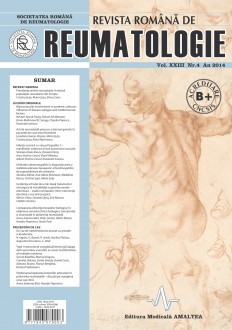SELECT ISSUE

Indexed

| |

|
|
|
| |
|
|
|

|
|
|
|
|
|
| |
|
|
HIGHLIGHTS
National Awards “Science and Research”
NEW! RJR has announced the annually National Award for "Science and Research" for the best scientific articles published throughout the year in the official journal.
Read the Recommendations for the Conduct, Reporting, Editing, and Publication of Scholarly work in Medical Journals.
The published medical research literature is a global public good. Medical journal editors have a social responsibility to promote global health by publishing, whenever possible, research that furthers health worldwide.
MACROVASCULAR INVOLVEMENT IN SYSTEMIC SCLEROSIS: INFLUENCE OF DISEASE SUBTYPE AND TRADITIONAL RISK FACTORS
Neveen Ayoub Farag, Seham Ali Mitawee, Eman Mahmoud EL Serogy, Claudiu Popescu and Ruxandra Ionescu
ABSTRACT
Objective. The present study aimed on one hand to test the hypothesis that patients with limited systemic sclerosis (LSSc) have a higher incidence of large vessel disease than patients with diffuse systemic sclerosis (DSSc) and to correlate it with traditional cardiovascular risk factors. On the other hand, we aimed to measure the extent of subclinical atherosclerosis in these patients, evaluating any potential clinical and laboratory vascular risk factor.
Methods. We randomly included in the study 59 systemic sclerosis patients hospitalized in 2013 in two rheumatology centers (Cairo University Hospitals Rheumatology Department and Research Center of the Pathology and Treatment of Systemic Rheumatic Diseases, Bucharest). Non-invasive vascular tests were done: internal and common carotid arteries intima-media thickness (IMT) using Doppler ultrasound, and ankle brachial index (ABI). Traditional vascular risk factors were assessed.
Results. Dividing the study sample into DSSc and LSSc produced several notable observations. The subgroups did not differ significantly by age, sex and disease duration, but ethnicity mattered: 83.3% of Egyptian patients had LSSc (25/30), while only 48.3% of Romanian patients had LSSc (14/29; p = 0.004). Generally, patients with LSSc had significantly higher values of erythrocyte sedimentation rate, alanin aminotransferase, lCIMT and significantly lower HDL levels. There were no significant differences in ABI among subgroups.
Conclusion. The limited phenotype of systemic sclerosis is associated with a more adverse cardiovascular risk profile compared to the diffuse phenotype.
Keywords: systemic sclerosis, ankle-brachial index, carotid duplex, cardiovascular risk
